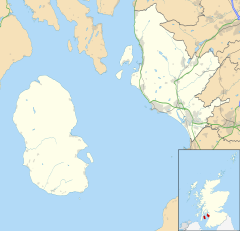Skelmorlie
| Skelmorlie | |
|---|---|
| Skelmorlie shown within North Ayrshire | |
| OS grid reference | NS195688 |
| Council area | |
| Lieutenancy area | |
| Country | Scotland |
| Sovereign state | United Kingdom |
| Post town | SKELMORLIE |
| Postcode district | PA17 |
| Dialling code | 01475 |
| Police | Scottish |
| Fire | Scottish |
| Ambulance | Scottish |
| EU Parliament | Scotland |
| UK Parliament | |
| Scottish Parliament | |
Skelmorlie is a village in North Ayrshire, Scotland. Although it is the northernmost settlement in the council area of North Ayrshire it is contiguous with Wemyss Bay, which is in Inverclyde. The dividing line is the Kelly Burn, which flows into the Firth of Clyde just south of the Rothesay ferry terminal. Despite their proximity, the two villages have historically been divided, Skelmorlie in Ayrshire and Wemyss Bay in Renfrewshire.
Skelmorlie itself is divided into two sections, Lower and Upper Skelmorlie. There is one primary school in this village, with secondary age pupils going to Largs Academy in North Ayrshire.
In common with this part of the Clyde foreshore the rich red sandstone is a prominent feature of the landscape and housing in Skelmorlie.
Skelmorlie's history is recorded as far back as the fifteenth century. Skelmorlie Castle, south of the village, is a tower house built on the site of an older structure in 1502. Much altered and added to since, it is an ancient seat of the Clan Montgomery (a notable burial tomb of the family can be seen at Skelmorlie Aisle in Largs). During the nineteenth century the village was once home to many Glasgow tea barons. On the cliff above the shore a large hydropathic institution once stood, with access from the main road via a lift whose shaft was hewn out of the rock face. The building later operated as a hotel, but was demolished in the 1990s.
To the south of Skelmorlie is the serpent mound, a prehistoric, perhaps druidic, site apparently carved either deliberately for religious uses or by nature then reused due to its natural shape.
On Saturday 18 April 1925, an embankment on the reservoir which belonged to the Eglinton Estate and provided the main water supply for the whole village gave way, releasing millions of gallons of water down through the village. After 10 minutes many homes, streets and gardens were shattered and five people, four of them children, lay dead.
...
Wikipedia

